 |
|
Популярные авторы:: БСЭ :: Говард Роберт Ирвин :: Нортон Андрэ :: Картленд Барбара :: Громов Дмитрий :: Дойл Артур Конан :: Раззаков Федор :: Толстой Лев Николаевич :: Лесков Николай Семёнович :: Андреев Леонид Николаевич Популярные книги:: Справочник по реестру Windows XP :: Черные очки :: Разведение cобак :: Воздушный шарик – Шарик-миротворец :: Дождик, дождик, пуще :: Дьявол в бархате :: Вавилонские сестры и другие постчеловеки :: Прекрасная лошадь :: Мясоеды :: На тебе греха не будет... |
11 сентября 2001ModernLib.Net / Публицистика / Мейссан Тьерри / 11 сентября 2001 - Чтение (стр. 15)
When originally constructed, the two towers were not provided with automatic fire sprinkler protection. However, such protection was installed as a retrofit circa 1990, and automatic sprinklers covered nearly 100 percent of WTC 1 and WTC 2 at the time of the September 11 attacks. In addition, each building had standpipes running through each of its three stairways. A 1.5-inch hose line and a cabinet containing two air pressurized water (APW) extinguishers were also present at each floor in each stairway. The primary water supply was provided by a dedicated fire yard main that looped around most of the complex. This yard main was supplied directly from the municipal water supply. Two remotely located high pressure, multi-stage, 750-gallons per minute (gpm) electrical fire pumps took suction from the New York City municipal water supply and produced the required operating pressures for the yard main. Each tower had three electrical fire pumps that provided additional pressure for the standpipes. One pump, located on the 7th floor, received the discharge from the yard main fire pumps and moved it up to the 41st floor, where a second 750-gpm fire pump pushed it up to a third pump on the 75th floor. Each fire pump produced sufficient pressure to supply water to the pump two stages up from it in the event that any one pump should fail. Several 5,000-gallon storage tanks, filled from the domestic water system, provided a secondary water supply. Tanks on the 41st, 75th, and 110th floors provided water directly to a standpipe system. A tank on the 20th floor supplied water directly to the yard main. Numerous Fire Department of New York (FDNY) connections were located around the complex to allow the fire department to boost water pressure in the buildings. A zoned smoke control system was built into each building's ventilation systems and was activated upon direction of the responding FDNY Incident Commander. The system was designed to limit smoke spread from the tenant areas to the core area, thereby assisting both individuals evacuating from an area and those responding to the scene by limiting smoke spread into the core. At the time of the 1993 World Trade Center bombing, a centralized Fire Command Center (FCC) for the two towers was present at the Concourse level. This FCC was located in the B-1 level Operations Control Center (OCC). Following the 1993 bombing, additional FCCs were installed in the lobbies of each tower. A Radiax cable and antenna were installed in the WTC complex to facilitate the use of FDNY radios in the towers. Fire department telephones were provided in both towers on odd floors in Stairway 3, as well as on levels B-1, B-4, and B-6. The WTC had its own fire brigade, consisting of Port Authority police officers trained in fire safety, who worked with the FDNY to investigate fire conditions and take appropriate actions. The internal fire brigade had access to fire carts located on the Concourse level and on the 44th and 78th floor sky lobbies of each tower. These fire carts were equipped with hoses, nozzles, self-contained breathing apparatus, turnout coats, forcible entry tools, resuscitators, first-aid kits, and other emergency equipment. Typically, the WTC fire brigade would collect the nearest fire cart and set up operations on the floor below the fire floor. The WTC complex had 24 Siamese connections located at street level for use by the FDNY apparatus. Each of these Siamese connections served various portions of the complex and was identified as such. Each tower was provided with three independent emergency fire exit stairways, located in the core of the building, as indicated in Figure 2-12. Two of these stairways, designated Stairway 1 and Stairway 2, were 44 inches wide and ran to the 110th floor. The third stairway, designated Stairway 3, had a width of 56 inches and ran to the 108th floor. The stairways did not run in continuous vertical shafts from the top to the bottom of the structure. Instead, the plan location of the stairways shifted at some levels, and occupants traversing the stairways were required to move from one vertical shaft to another through a transfer corridor. Both Stairways 1 and 2 had transfers at the 42nd, 48th, 76th, and 82nd levels. Stairway 1 had an additional transfer at the 26th level and Stairway 3 had a single transfer at the 76th level. After the 1993 bombing, battery-operated emergency lighting was provided in the stairways and photoluminescent paint was placed on the edge of the stair treads to facilitate emergency egress. 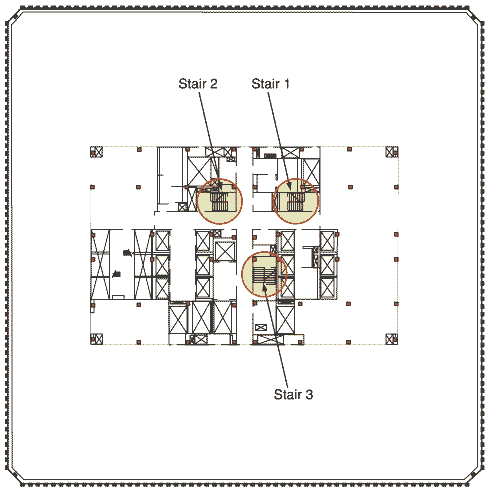 Figure 2-12. Floor plan of 94th and 95th floors of WTC 1 showing egress stairways. There were 99 elevators in each of the two towers, including 23 express elevators; however, the express elevators were not intended to be used for emergency access or egress. There were also several freight elevators servicing groups of floors in the buildings. The several elevators that served each floor were broken into two groups that operated on different power supplies. Upon alarm activation, an automatic elevator override system commanded all elevators serving or affected by a fire area to immediately return to the ground floor, or to their sky lobby (44th and 78th floors). From there, the elevators could be operated manually by the FDNY. Although many fire departments routinely use elevators to provide better access in high-rise buildings, FDNY does not do this, because there have been fatalities associated with such use. Primary power was provided at 13.8 kilovolts (kV) through a ground level substation in WTC 7 near the Barclay Street entrance to the underground parking garage. The primary power was wired to the buildings through two separate systems. The first provided power throughout each building; the second provided power to emergency systems in the event that the primary wiring system failed. Six 1,200-kilowatt (kW) emergency power generators located in the sixth basement (B-6) level provided a secondary power supply. These generators were checked on a routine basis to ensure that they would function properly during an emergency. This equipment provided backup power for communications equipment, elevators, emergency lighting in corridors and stairwells, and fire pumps. Telephone systems were provided with an independent battery backup system. Emergency lighting units in exit stairways, elevator lobbies, and elevator cabs were equipped with individual backup batteries. The Port Authority has a risk management group that coordinates fire and safety activities for their various properties. This group provided training for the WTC fire brigade, fire safety directors, and tenant fire wardens. The WTC had 25 fire safety directors who assisted in the coordination of fire safety activities in the buildings throughout the year. Six satellite communication stations, staffed by deputy fire safety directors, were spaced throughout the towers. In addition, each tenant was required to provide at least one fire warden. Tenants that occupied large areas of the building were required to provide one fire warden for every 7,500 square feet of occupied space. The fire safety directors trained the fire wardens and fire drills were held twice a year. 2.2 Building Response WTC 1 and WTC 2 each experienced a similar, though not identical, series of loading events. In essence, each tower was subjected to three separate, but related events (actually, there were four separate, but related events, the last being the detonation of a multitude of small explosive charges in each building). The sequence of these events was the same for the two buildings, although the timing was not. In each case, the first loading event was a Boeing 767-200ER series commercial aircraft hitting the building, together with a fireball (Although dramatic, these fireballs did not explode or generate a shock wave. If an explosion or detonation had occurred, the expansion of the burning gasses would have taken place in microseconds, not the 2 seconds observed. Therefore, although there were some overpressures, it is unlikely that the fireballs, being external to the buildings, would have resulted in significant structural damage.) resulting from immediate rapid ignition of a portion of the fuel on board the aircraft. Boeing 767-200ER aircraft have a maximum rated takeoff weight of 395,000 pounds, a wingspan of 156 feet 1 inch, and a rated cruise speed of 530 miles per hour. The aircraft is capable of carrying up to 23,980 gallons of fuel and it is estimated that, at the time of impact, each aircraft had approximately 10,000 gallons of unused fuel on board (compiled from Government sources). Boeing 707-320B aircraft have a maximum rated takeoff weight of 336,000 pounds, a wingspan of 145 feet 9 inches, and a rated cruise speed of 607 miles per hour. The aircraft is capable of carrying over 23,000 gallons of fuel. The Boeing 707 and 767 are very similar aircraft. Under normal flying conditions, a Boeing 707 would smash into a building with about 10 percent more energy than would the slightly heavier Boeing 767. Engineers designed the World Trade Center towers to withstand a collision with a Boeing 707. Hence, they were necessarily designed to survive the impact of a Boeing 767. See The World Trade Center Demolition and Microsoft Software Used To Simulate The Crash Of A Boeing 747 Into The World Trade Centre. In each case, the aircraft impacts resulted in severe structural damage, including some localized partial collapse, but did not result in the initiation of global collapse. In fact, WTC 1 remained standing for a period of approximately 1 hour and 43 minutes, following the initial impact; WTC 2 remained standing for approximately 56 minutes following impact. The second event was the simultaneous ignition and growth of fires over large floor areas on several levels of the buildings. The fires heated the structural systems and, over a period of time, resulted in additional stressing of the damaged structure, as well as sufficient additional damage and strength loss to initiate the third event, a progressive sequence of failures that culminated in total collapse of both structures. Of course, this does not even begin to explain the total collapse of WTC Seven. American Airlines Flight 11 struck the north face of WTC 1 approximately between the 94th and 98th floors (Figures 2-13 and 2-14), causing massive damage to the north face of the building within the immediate area (Figure 2-15). 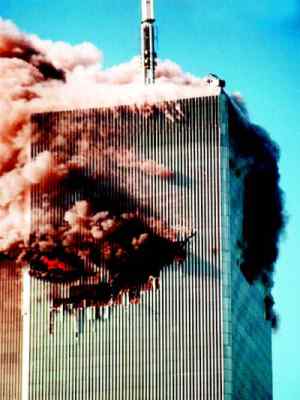 Figure 2-13 Zone of aircraft impact on the north face of WTC 1. At the central zone of impact corresponding to the airplane fuselage and engines, at least five of the prefabricated, three-column sections that formed the exterior walls were broken loose of the structure, and some were pushed inside the building envelope. 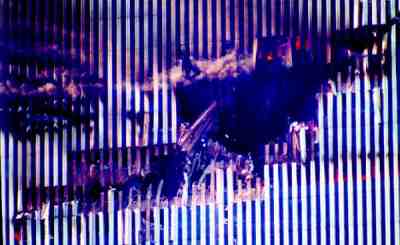 Figure 2-15 Impact damage to the north face of WTC 1. Locally, floors supported by these exterior wall sections appear to have partially collapsed, losing their support along the exterior wall. Away from this central zone, in areas impacted by the outer wing structures, the exterior columns were fractured by the force of the collision. Interpretation of photographic evidence suggests that from 31 to 36 columns on the north building face were destroyed over portions of a four-story range. Partial collapse of floors in this zone appear to have occurred over a horizontal length of wall of approximately 65 feet, while floors in other portions of the building appear to have remained intact. Figure 2-16 shows the damage to the exterior columns on the impacted face of WTC 1. 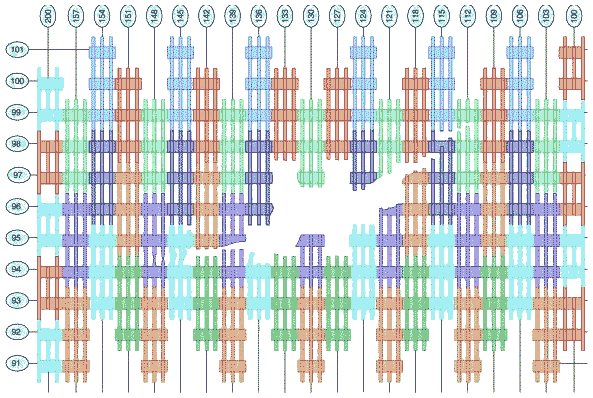 General notes: (1) column damage captured from photographs and enchanced video, (2) Damage to column lines 111-115 at level 96 is estimated. Figure 2-16 Impact damage to exterior columns on the north face of WTC 1. In addition to this damage at the building perimeter, a significant but undefined amount of damage also occurred to framing at the central core. For an estimate of the likely damage to the central core (by the University of California, Berkeley professor, Astaneh-Asl) see the article Microsoft Software Used To Simulate The Crash Of A Boeing 747 Into The World Trade Centre. This article claims that the damage caused by the much, much larger and heavier Boeing 747, in a collision with the World Trade Center, would be insufficient to bring the central core down. Interviews were conducted with persons who were present in offices on the 91st floor of the building at the north face of the structure, three floors below the approximate zone of impact. Their descriptions of the damage evident at this floor level immediately following the aircraft impact suggest relatively slight damage at the exterior wall of the building, but progressively greater damage to the south and east. They described extensive building debris in the eastern portion of the central core, preventing their access to the easternmost exit stairway. This suggests the possibility of immediate partial collapse of framing in the central core. These persons also described the presence of debris from collapsed partition walls from upper floors in stairways located further to the west, suggesting the possibility of some structural damage in the northwestern portion of the core framing as well. Figure 2-17 is a sketch made during an interview with building occupants indicating portions of the 91st floor that could not be accessed due to accumulated debris. 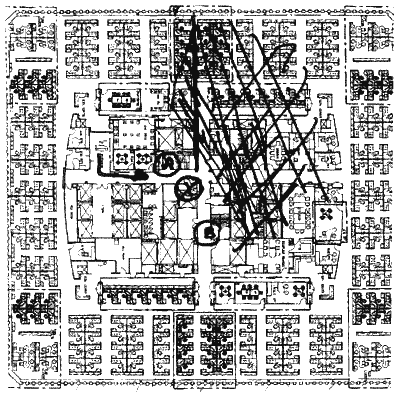 Figure 2-17 Approximate debris location on the 91st floor of WTC 1. It is known that some debris from the aircraft traveled completely through the structure. For example, life jackets and portions of seats from the aircraft were found on the roof of the Bankers Trust building, located to the south of WTC 2. Part of the landing gear from this aircraft was found at the corner of West and Rector Streets, some five blocks south of the WTC complex (Figure 2-18). 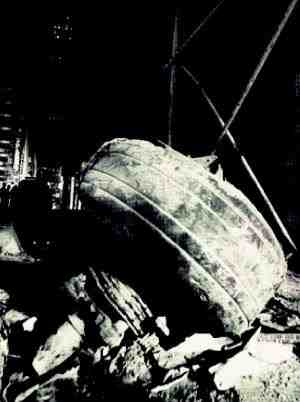 Figure 2-18 Landing gear found at the corner of West and Rector Streets. As this debris passed through the building, it doubtless caused some level of damage to the structure across the floor plate, including, potentially, interior framing, core columns, framing at the east, south, and west walls, and the floors themselves. The exact extent of this damage will likely never be known with certainty. It is evident that, despite this damage, the structure retained sufficient integrity and strength to remain globally stable for a period of approximately 1 hour and 43 minutes. The building's structural system, composed of the exterior loadbearing frame, the gravity loadbearing frame at the central core, and the system of deep outrigger trusses in upper stories, was highly redundant. This permitted the building to limit the immediate zone of collapse to the area where several stories of exterior columns were destroyed by the initial impact and, perhaps, to portions of the central core as previously described. Following the impact, floor loads originally supported by the exterior columns in compression were successfully transferred to other load paths. Most of the load supported by the failed columns is believed to have transferred to adjacent perimeter columns through Vierendeel behavior of the exterior wall frame. This is not true. The extra vertical load on the perimeter columns would have distributed itself symmetrically around the perimeter frame (and would not have been concentrated on the adjacent columns). Preliminary structural analyses of similar damage to WTC 2 suggests that axial load demands on columns immediately adjacent to the destroyed columns may have increased by as much as a factor of 6 relative to the load state prior to aircraft impact. However, these exterior columns appear to have had substantial overstrength for gravity loads. Indeed, these exterior columns were designed to resist significant lateral loading and would have had more than sufficient capacity to resist this extra load.  Figure 2-14 Approximate zone of impact of aircraft on the north face of WTC 1. Neglecting the potential loss of lateral support resulting from collapsed floor slabs and any loss of strength due to elevated temperatures from fires, the most heavily loaded columns were probably near, but not over, their ultimate capacities. Columns located further from the impact zone are thought to have remained substantially below their ultimate capacities. The preliminary analyses also indicate that loss of the columns resulted in some immediate tilting of the structure toward the impact area (extremely unlikely) subjecting the remaining columns and structure to additional stresses from P-delta effects. Also, in part, exterior columns above the zone of impact were converted from compression members to hanger-type tension members, so that, in effect, a portion of the floors' weight became suspended from the outrigger trusses (Figure 2-10) and were transferred back to the interior core columns. The outrigger trusses also would have been capable of transferring some of the load carried by damaged core columns to adjacent core columns. Figure 2-19 illustrates these various secondary load paths. Section 2.2.2.2 provides a more detailed description of these analyses and findings. The above paragraph is mainly nonsense. The building was in fact unlikely to have been stressed any more than it would have been in a hurricane force wind. 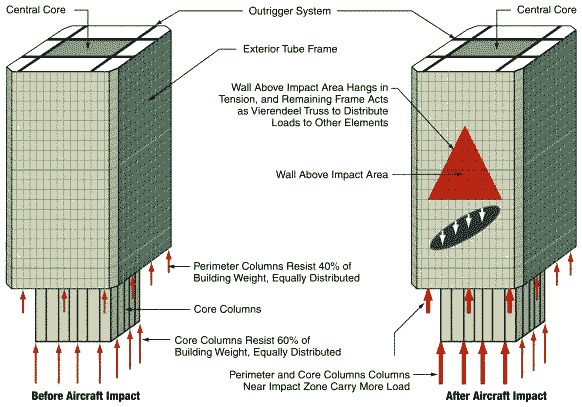 Figure 2-19 Redistribution of load after aircraft impact. 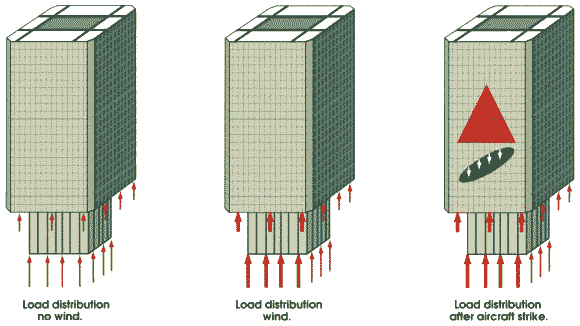 The resulting load distribution after the aircraft impact would have been almost identical to the load distribution incurred by strong wind from the back (i.e., from behind the plane of the page) as in the above graphic. Following the aircraft impact into the building, the structure was able to successfully redistribute the building weight to the remaining elements and to maintain a stable condition. This return to a stable condition is suggested by the preliminary analyses and also evidenced by the fact that the structure remained standing for 1 hour and 43 minutes following the impact. However, the structure's global strength was severely degraded. Although the structure may have been able to remain standing in this weakened condition for an indefinite period, it had limited ability to resist additional loading and could potentially have collapsed as a result of any severe loading event, such as that produced by high winds or earthquakes. WTC 1 probably experienced some additional loading and damage due to the collapse of the adjacent WTC 2. The extent of such damage is not known but likely included broken window and facade elements along the south face. This additional damage was not sufficient to cause collapse. The first event of sufficient severity to cause collapse was the fires that followed the aircraft impact. It is estimated, based on information compiled from Government sources, that each aircraft contained about 10,000 gallons of jet fuel upon impact into the buildings. A review of photographic and video records show that the aircraft fully entered the buildings prior to any visual evidence of flames at the exteriors of the buildings. This suggests that, as the aircraft crashed into and plowed across the buildings, they distributed jet fuel throughout the impact area to form a flammable «cloud.» Ignition of this cloud resulted in a rapid pressure rise, expelling a fuel rich mixture from the impact area into shafts and through other openings caused by the crashes, resulting in dramatic fireballs. Although only limited video footage is available that shows the crash of American Airlines Flight 11 into WTC 1 and the ensuing fireballs, extensive video records of the impact of United Airlines Flight 175 into WTC 2 are available. These videos show that three fireballs emanated from WTC 2 on the south, east, and west faces. The fireballs grew slowly, reaching their full size after about 2 seconds. The diameters of the fireballs were greater than 200 feet, exceeding the width of the building. Such fireballs were formed when the expelled jet fuel dispersed and flames traveled through the resulting fuel/air mixture. Experimentally based correlations for similar fireballs (Zalosh 1995) were used to estimate the amount of fuel consumed. The precise size of the fireballs and their exact shapes are not well defined; therefore, there is some uncertainty associated with estimates of the amount of fuel consumed by these effects. Calculations indicate that between 1,000 and 3,000 gallons of jet fuel were likely consumed in this manner. Barring additional information, it is reasonable to assume that an approximately similar amount of jet fuel was consumed by fireballs as the aircraft struck WTC 1. Although dramatic, these fireballs did not explode or generate a shock wave. If an explosion or detonation had occurred, the expansion of the burning gasses would have taken place in microseconds, not the 2 seconds observed. Therefore, although there were some overpressures, it is unlikely that the fireballs, being external to the buildings, would have resulted in significant structural damage. It is not known whether the windows that were broken shortly after impact were broken by these external overpressures, overpressures internal to the building, the heat of the fire, or flying debris. The first arriving firefighters observed that the windows of WTC 1 were broken out at the Concourse level. This breakage was most likely caused by overpressure in the elevator shafts. Damage to the walls of the elevator shafts was also observed as low as the 23rd floor, presumably as a result of the overpressures developed by the burning of the vapor cloud on the impact floors. If one assumes that approximately 3,000 gallons of fuel were consumed in the initial fireballs, then the remainder either escaped the impact floors in the manners described above or was consumed by the fire on the impact floors. If half flowed away, then approximately 4,000 gallons remained on the impact floors to be consumed in the fires that followed. The jet fuel in the aerosol would have burned out as fast as the flame could spread through it, igniting almost every combustible on the floors involved. Fuel that fell to the floor and did not flow out of the building would have burned as a pool or spill fire at the point where it came to rest. The time to consume the jet fuel can be reasonably computed. At the upper bound, if one assumes that all 10,000 gallons of fuel were evenly spread across a single building floor, it would form a pool that would be consumed by fire in less than 5 minutes (SFPE 1995) provided sufficient air for combustion was available. In reality, the jet fuel would have been distributed over multiple floors, and some would have been transported to other locations. Some would have been absorbed by carpeting or other furnishings, consumed in the flash fire in the aerosol, expelled and consumed externally in the fireballs, or flowed away from the fire floors. Accounting for these factors, it is believed that almost all of the jet fuel that remained on the impact floors was consumed in the first few minutes of the fire. As the jet fuel burned, the resulting heat ignited office contents throughout a major portion of several of the impact floors, as well as combustible material within the aircraft itself. A limited amount of physical evidence about the fires is available in the form of videos and still photographs of the buildings and the smoke plume generated soon after the initial attack. Estimates of the buoyant energy in the plume were obtained by plotting the rise of the smoke plume, which is governed by buoyancy in the vertical direction and by the wind in the horizontal direction. Using the Computational Fluid Dynamics (CFD) fire model, Fire Dynamics Simulator Ver. 1 (FDS1), fire scientists at the National Institute of Standards and Technology (NIST) (Rehm, et al. 2002) were able to mathematically approximate the size of fires required to produce such a smoke plume. As input to this model, an estimate of the openings available to provide ventilation for the fires was obtained from an examination of photographs taken of the damaged tower. Meteorological data on wind velocity and atmospheric temperatures were provided by the National Oceanic and Atmospheric Administration (NOAA) based on reports from the Aircraft Communications Addressing and Reporting System (ACARS). The information used weather monitoring instruments onboard three aircraft that departed from LaGuardia and Newark airports between 7:15 a.m. and 9:00 a.m. on September 11, 2001. The wind speed at heights equal to the upper stories of the towers was in the range of 10-20 mph. The outside temperatures over the height of the building were 20-21 degrees Centigrade (68-70 degrees Fahrenheit). The modeling suggests a peak total rate of fire energy output on the order of 3-5 trillion Btu/hr, around 1-1.5 gigawatts (GW), for each of the two towers. From one third to one half of this energy flowed out of the structures. This vented energy was the force that drove the external smoke plume. The vented energy and accompanying smoke from both towers combined into a single plume. The energy output from each of the two buildings is similar to the power output of a commercial power generating station (this is the same type of misleading statement that the «Scientific» American article made, in its description of the aircraft strikes and fires in the WTC as equivalent to small nuclear weapons going off). The modeling also suggests ceiling gas temperatures of 1,000 degrees Centigrade (1,800 degrees Fahrenheit), for all of 5 minutes, until the jet-fuel burnt off, with an estimated confidence of plus or minus 100 degrees Centigrade (200 degrees Fahrenheit) or about 900-1,100 degrees Centigrade (1,600-2,000 degrees Fahrenheit). This is impossible, as it is well known that the maximum temperature that can be reached by a non-stoichiometric hydrocarbon burn (that is, hydrocarbons like jet-fuel, burning in air) is 825 degrees Centigrade (1520 degrees Fahrenheit). Even worse, the WTC fires were fuel rich (as evidenced by the thick black smoke) and thus did not reach anywhere near this upper limit of 825 degrees. In fact, the WTC fires would have burnt at, or below, temperatures typical in office fires. If the temperatures inside large regions of the building were above 700 degrees Centigrade, then these regions would have glowing red hot and there would have been visible signs of this from the outside. Even pictures taken from the air looking horizontally into the impact region show little or no sign of severe burning (above 700 degrees Centigrade). When temperatures above 700 degrees Centigrade are reached within a region, this results in the breaking of the windows within that region. However, once the blast and fireball effects of the impacts had subsided, there appeared to be no ongoing window breakage from either tower, either as evidenced from pictures or video footage or as reported from the ground. In fact, significant areas of window even remained intact within the impact region. This is further evidence that fully developed fire conditions did not spread much through and beyond the initial devastated region, following the impacts. In contrast, the First Interstate Bank fire in Los Angeles showed greater heating effects over larger regions than those observed in either tower. The temperature attained by the First Interstate Bank fire was clearly greater than that of either of the twin towers as the fire was hot enough to break the window glass (which rained down on the streets below presenting a considerable hazard to those on the ground). The First Interstate Bank did not collapse. A major portion of the uncertainty in these estimates is due to the scarcity of data regarding the initial conditions within the building and how the aircraft impact changed the geometry and fuel loading. Temperatures may have been as high as 900-1,100 degrees Centigrade (1,700-2,000 degrees Fahrenheit) in some areas and 400-800 degrees Centigrade (800-1,500 degrees Fahrenheit) in others. All this talk of such high temperatures is to convince you that the steel beams and columns must have got really hot, but this is not so. For example, a ceiling gas temperature of 1,800 degrees Fahrenheit, for 5 minutes, would not heat the steel beams and columns significantly and the typical office fire that followed would not heat them to the point of collapse (trusses however, may have been significantly affected (this is the reason why the «truss theory» became popular)). It should be noted that the twin towers were designed to survive much more serious fires than those that occurred on September 11. That is the law. 1, 2, 3, 4, 5, 6, 7, 8, 9, 10, 11, 12, 13, 14, 15, 16, 17, 18, 19 |
|||||||